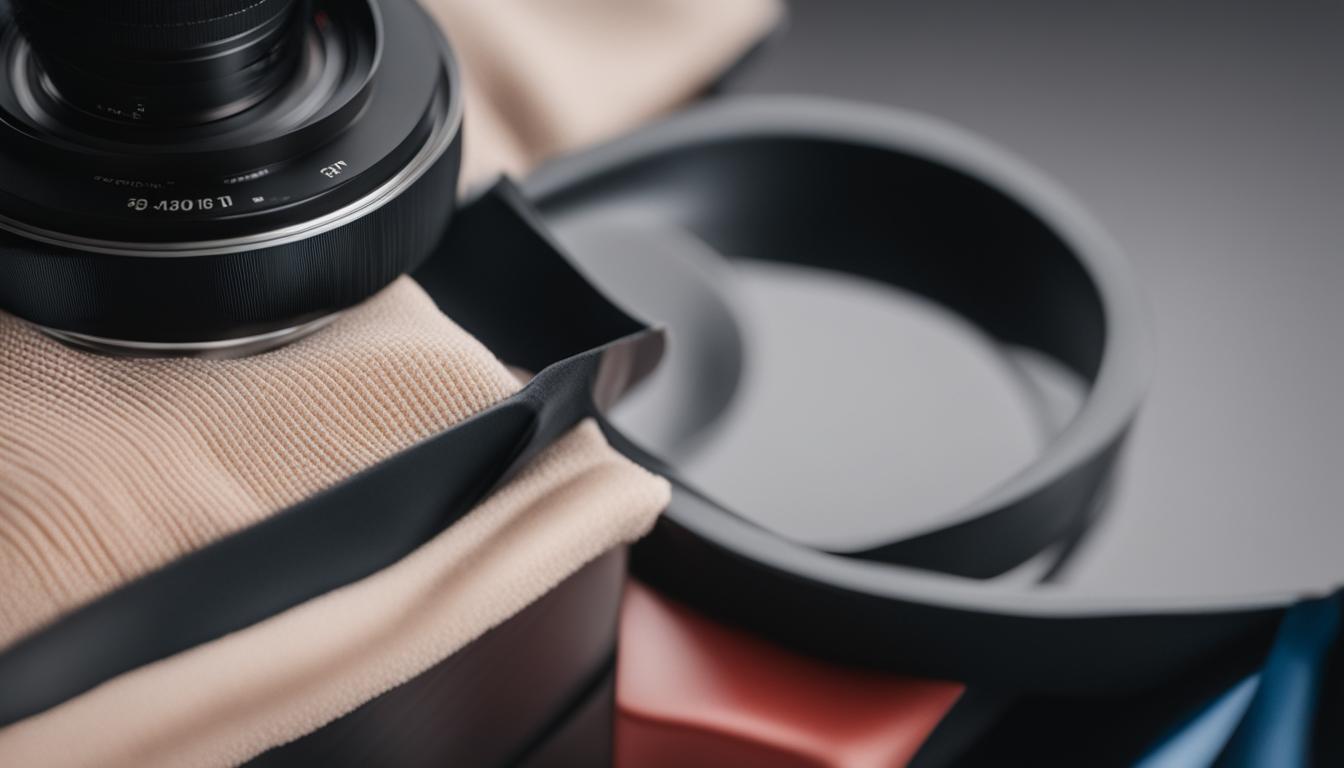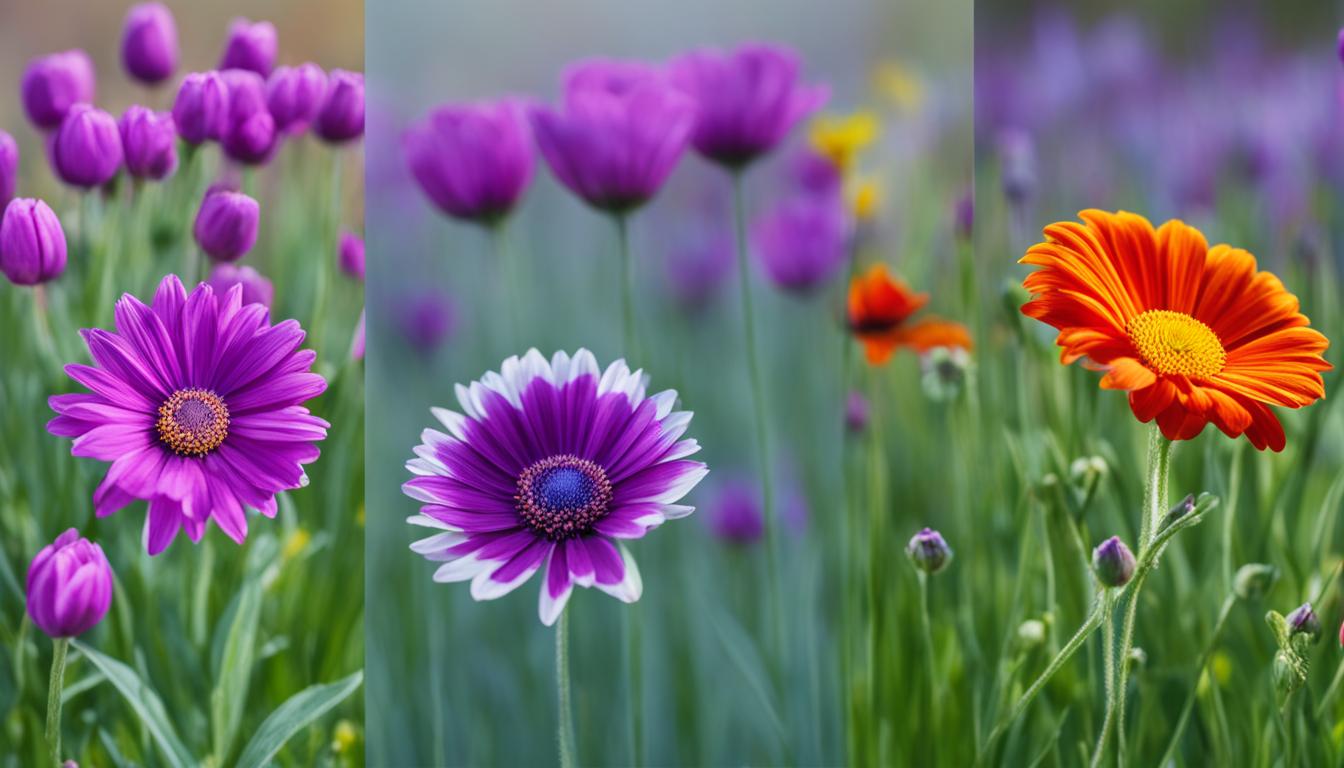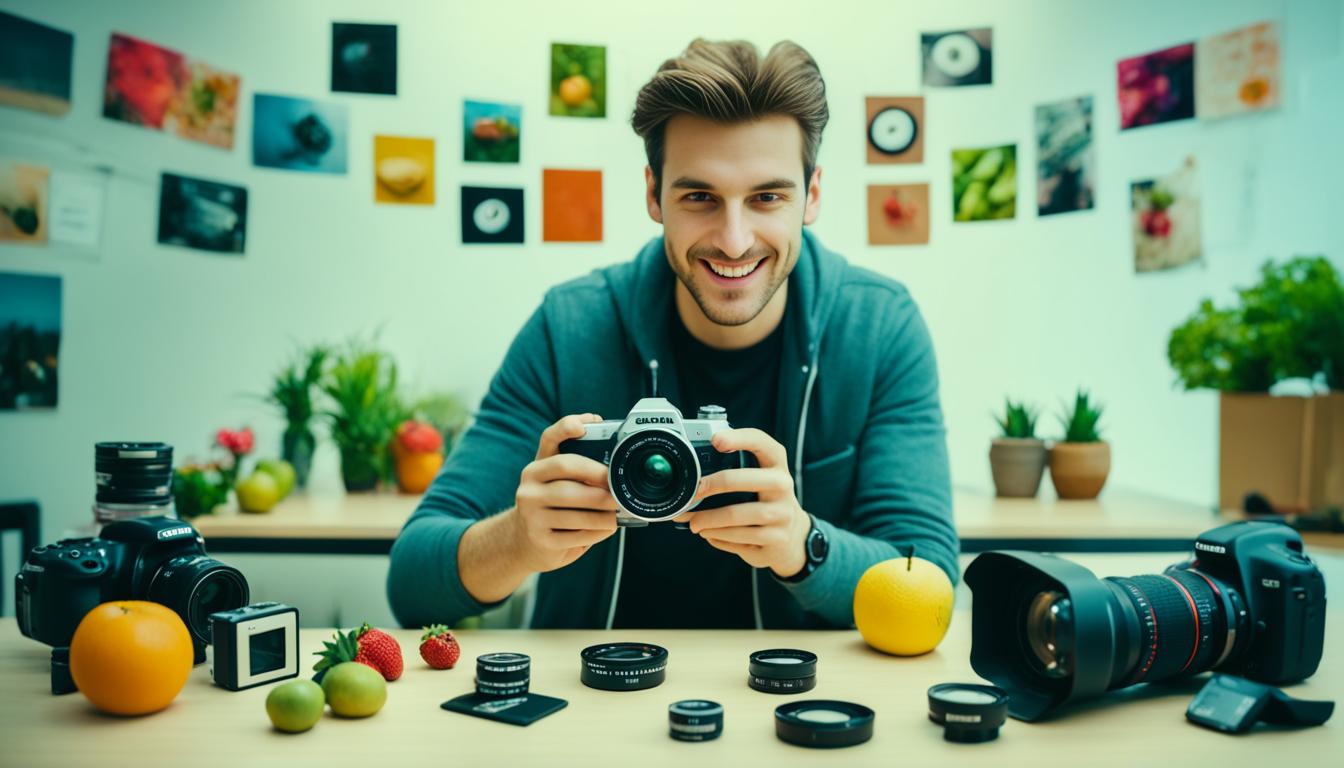Maintaining and cleaning your camera gear is essential to ensure its longevity and optimal performance. Proper care and maintenance can help protect your equipment from damage and keep it in top condition for years to come. In this comprehensive guide, we will provide you with expert tips and techniques for maintaining and cleaning your camera gear. Whether you’re a professional photographer or an enthusiast, these practices will help you keep your equipment spotless and functioning at its best.
Key Takeaways
- Regular maintenance and cleaning are crucial for the longevity and performance of your camera gear.
- Proper maintenance can prevent issues such as dust on the sensor, lens damage, and malfunctioning buttons.
- Essential cleaning tools include a rocket blower, lens pen, lens wipes, microfiber cloths, and brushes.
- Camera lenses should be cleaned using a step-by-step process that includes removing dust and cleaning the glass.
- A clean camera sensor is important to prevent visible spots and blemishes in your photographs.
The Importance of Camera Maintenance
Your camera equipment is a valuable investment, and proper maintenance is crucial to protect it. Regular maintenance not only extends the lifespan of your gear but also ensures that it consistently produces high-quality images. By following best practices for camera maintenance, you can prevent potential issues such as dust on the sensor, damage to the lens, or malfunctioning buttons and dials. In this section, we will delve into why camera maintenance is important and how it can benefit you in the long run.
When it comes to camera care, prevention is key. Regularly cleaning and maintaining your camera gear can help you avoid costly repairs and ensure that your equipment performs at its best. Here are some essential camera care instructions and best practices to keep in mind:
- Keep your camera equipment clean: Regularly clean your lenses, camera body, and accessories to remove dust, dirt, and smudges. Use a soft microfiber cloth or lens pen to gently wipe the surfaces and avoid scratching the lens or sensor.
- Protect your camera from extreme conditions: Avoid exposing your camera gear to extreme temperatures, high humidity, or direct sunlight. These conditions can cause damage to the internal components and affect the performance of your equipment.
- Store your camera properly: When not in use, store your camera gear in a dry and dust-free environment. Use protective cases or bags to prevent accidental damage and keep your equipment organized.
- Handle your camera with care: Always use caution when handling your camera gear. Avoid dropping or banging your equipment, and be mindful of the delicate components such as the lens, sensor, and buttons.
By following these camera care instructions and best practices for maintenance, you can ensure that your gear remains in optimal condition and continues to deliver outstanding results. Now let’s explore each aspect of camera maintenance in detail.
“Proper camera maintenance is essential for protecting your investment and ensuring high-quality images.”
Essential Cleaning Tools and Supplies
To effectively clean and maintain your camera gear, it’s essential to have the right tools and supplies. In this section, we will introduce you to some essential cleaning items for your camera gear.
- Rocket Blower: A rocket blower is a handheld device that uses a burst of air to remove dust and debris from your lenses, camera bodies, and other equipment. It’s a gentle and effective way to keep your gear clean without risking damage.
- Lens Pen: A lens pen is a compact tool with a brush on one end and a cleaning tip on the other. It’s designed to remove fingerprints, smudges, and other smears from your camera lens.
- Pre-Moistened Lens Wipes: These disposable wipes are specially formulated to clean lenses and remove dirt, oils, and smudges. They are convenient to use and leave no residue behind.
- Microfiber Cleaning Cloths: Microfiber cloths are soft and lint-free, making them ideal for cleaning delicate camera surfaces. They effectively remove dust and smudges without scratching or leaving marks.
- Paint Brush: A small, soft-bristled paint brush can be used to gently remove dust and debris from hard-to-reach areas of your camera gear, such as buttons and crevices.
- Make-up Brush: Similar to a paint brush, a clean make-up brush with soft bristles can be used to remove dust and debris from your camera equipment.
- Teck Towel: Teck Towels are highly absorbent and lint-free, making them perfect for drying and cleaning your camera gear. They are non-abrasive and won’t scratch delicate surfaces.
- Zip-Lock Bag: A zip-lock bag is a simple but effective way to store your cleaning tools and protect them from dust and contamination when not in use.
By having these essential cleaning tools and supplies in your camera bag, you’ll be equipped to keep your gear in top condition and ensure optimal performance.
Cleaning Your Camera Lenses
Camera lenses are highly susceptible to dust, smudges, and other contaminants that can significantly impact the quality of your images. To ensure optimal performance and maintain the clarity of your lenses, it is essential to clean them regularly using the right techniques. In this section, we will guide you through a step-by-step process for cleaning your camera lenses, using equipment such as a rocket blower, lens pen, and microfiber cloth.
Step 1: Remove Dust
The first step in cleaning your camera lens is to remove any dust particles that may have settled on the surface. To do this, use a rocket blower to gently blow air onto the lens, directing the airflow away from the camera body. This will help dislodge any loose debris without the risk of scratching the lens.
Step 2: Clean the Glass
After removing dust, it’s time to clean the lens glass. You can do this using either a lens pen or a microfiber cloth. For handheld lens pens, gently brush the lens surface in a circular motion to remove smudges and fingerprints. Alternatively, for microfiber cloths, lightly dampen the cloth with a lens cleaning solution or isopropyl alcohol and gently wipe the glass in a circular motion. Avoid applying too much pressure to prevent scratching the lens.
Pro Tip: Always use a lens cleaning solution specifically designed for camera lenses. Avoid using household cleaning products, as they may contain chemicals that can damage the lens coating.
Step 3: Remove Stubborn Stains
If you encounter stubborn stains or marks that cannot be removed with a lens pen or microfiber cloth, you may need to use a specialized lens cleaning solution. Apply a small amount of the cleaning solution to a microfiber cloth and gently rub the affected area in a circular motion. Be cautious not to apply excessive force, as it may cause scratching.
Step 4: Dry and Inspect
Once you have cleaned the lens, use a dry section of the microfiber cloth to gently dry it. It’s essential to ensure that no moisture or residue remains on the lens surface. Finally, inspect the lens under good lighting conditions to check for any missed spots or smudges.
| Cleaning Tools | Description |
|---|---|
| Rocket Blower | A handheld air blower used to remove dust particles from camera lenses and sensors. |
| Lens Pen | A pen-shaped tool with a soft brush one end and a cleaning tip on the other, designed specifically for cleaning camera lenses. |
| Microfiber Cloth | A soft cloth made of microfibers that are gentle on lens surfaces and effectively remove smudges and fingerprints. |
| Lens Cleaning Solution | A specialized solution formulated for cleaning camera lenses, ensuring safe and effective removal of stains and dirt. |
Cleaning Your Camera Sensor
A dirty camera sensor can result in visible spots and blemishes in your photographs. Cleaning your camera sensor is an essential step in maintaining the integrity of your images. In this section, we will guide you through the process of sensor cleaning, ensuring that your photos remain spotless.
Before you start cleaning your camera’s sensor, it is important to understand your camera’s built-in sensor cleaning system. Many cameras today have a self-cleaning mechanism that helps remove dust particles from the sensor. This system uses ultrasonic vibrations or other methods to shake off loose debris. To activate this function, consult your camera’s manual or settings menu.
However, even with the self-cleaning system, some stubborn particles may still adhere to the sensor. In such cases, manual cleaning becomes necessary. Before attempting manual cleaning, make sure you have the following tools:
- Rocket blower: Use the blower to remove loose dust particles from the sensor. Gently squeeze the blower to create a stream of air and direct it towards the sensor.
- Sensor cleaning swabs: These specialized swabs are designed to safely remove any remaining debris from the sensor surface. Choose swabs that are the correct size for your camera’s sensor.
- Sensor cleaning fluid: Apply a small amount of sensor cleaning fluid to the swab. Make sure to use a fluid specifically formulated for sensor cleaning to avoid any damage.
- Loupe or magnifier: These tools will help you inspect the sensor and ensure that it is clean before you resume shooting.
When cleaning your camera sensor, it is crucial to follow these steps:
- Ensure that your camera’s battery is fully charged, or connect it to a reliable power source to prevent any issues during the cleaning process.
- Set your camera to manual sensor cleaning mode. This mode will lock the sensor in place, preventing any accidental movement.
- Remove the lens from your camera body and activate the sensor cleaning function, if available. This will help dislodge any loose debris.
- Using the rocket blower, gently blow air onto the sensor to remove any remaining dust particles. Be careful not to touch the sensor surface with the blower tip.
- Inspect the sensor with a loupe or magnifier to identify any remaining spots or smudges.
- If necessary, apply a small amount of sensor cleaning fluid to the swab as per the manufacturer’s instructions.
- Gently and smoothly swipe the swab across the sensor surface, starting from one edge and moving to the other. Be cautious not to press too hard or apply excessive force.
- Inspect the sensor again to ensure that it is clean. If spots or smudges persist, you may need to repeat the process with a new swab.
- Once satisfied with the sensor’s cleanliness, turn off the manual sensor cleaning mode and carefully reattach the lens.
“A clean sensor is crucial for producing high-quality images. Regularly cleaning your camera sensor will minimize the need for post-processing retouching and ensure your photos remain pristine.”
– Professional Photographer

| Tools for Cleaning Your Camera Sensor: | Benefits |
|---|---|
| Rocket blower | Easily removes loose dust particles from the sensor. |
| Sensor cleaning swabs | Safely removes stubborn debris from the sensor’s surface. |
| Sensor cleaning fluid | Aids in effectively cleaning the sensor without causing damage. |
| Loupe or magnifier | Allows for thorough inspection of the sensor’s cleanliness. |
Protecting Your Camera in Wet Weather
Moisture and water can pose a serious threat to your camera gear. To ensure the longevity and functionality of your equipment, it’s crucial to take proactive measures when shooting in wet weather conditions. In this section, we will discuss effective strategies for protecting your camera from water damage and maintaining its optimal performance.
Using Camera Covers
When shooting in wet weather, investing in a reliable camera cover is essential. These covers provide a protective barrier against rain, snow, and other forms of moisture. Make sure to choose a cover that is specifically designed for your camera model to ensure a snug fit and maximum protection. By using a camera cover, you can shield your gear from water and prevent irreversible damage.
Ensuring Weather Sealing
Many modern camera models come equipped with weather sealing, a feature designed to provide additional protection against moisture and dust. It’s important to regularly check and maintain the integrity of your camera’s weather sealing to ensure its effectiveness. Refer to your camera’s manual for instructions on how to properly maintain and test the weather sealing. By keeping your camera’s weather sealing in good condition, you can minimize the risk of water penetration.
Properly Drying Your Equipment
After shooting in wet weather, it’s crucial to thoroughly dry your camera gear to prevent moisture buildup. Start by wiping down the exterior of your camera body with a soft, lint-free cloth to remove any water droplets. Be gentle and avoid applying excessive pressure to delicate parts. For hard-to-reach areas, use a small brush or a microfiber cloth to absorb any remaining moisture.
Additionally, remove the lens from the camera body and carefully dry both the front and rear elements. Inspect the lens mount for any signs of water or moisture and gently wipe it clean. To further expedite the drying process, you can use a hairdryer on a low heat setting from a safe distance. However, exercise caution and avoid exposing your camera equipment to excessive heat. Allow your gear to air dry in a well-ventilated area to ensure thorough drying.
By following these steps and taking the necessary precautions, you can effectively protect your camera gear from water damage and preserve its functionality. Remember, prevention is key, especially when it comes to maintaining your valuable equipment in wet weather conditions.
| Effective Tips for Protecting Your Camera in Wet Weather | |
|---|---|
| 1. Use camera covers | Invest in a camera cover specifically designed for your camera model to shield it from rain and moisture. |
| 2. Check weather sealing | Regularly inspect and maintain the weather sealing of your camera to ensure effective protection against water. |
| 3. Thoroughly dry your gear | After shooting in wet conditions, wipe down your camera and lens with a cloth, and air dry them to remove any moisture. |
Traveling with Your Camera Gear
When it comes to traveling with your camera gear, taking extra precautions is essential to ensure its safety and longevity. In this section, we will share our expert tips, best practices, and essential gear care guidelines to help you protect your equipment while on the move.
1. Use Protective Bags for Lenses
Investing in high-quality, padded camera bags or lens cases is crucial for safeguarding your lenses during transit. These bags provide added protection against bumps, shocks, and other potential damages. Make sure to choose bags that fit your lenses snugly, minimizing any movement during travel.
2. Carry Spare Lens and Body Caps
Accidents can happen, and lens or body caps may get lost or damaged while traveling. To avoid exposing your camera gear to dust or debris, always carry spare lens and body caps. This small yet essential step can help maintain the cleanliness and functionality of your equipment.
3. Store Gear in Low-Humidity Environments
Humidity can cause moisture buildup, leading to potential damage to your camera gear. When traveling to humid climates, store your equipment in low-humidity environments, such as airtight plastic bags or dry cabinets. This will help prevent moisture-related issues like fungus growth and corrosion.
Expert Tip: Desiccant packs can effectively absorb excess moisture when placed inside your camera bag. Don’t forget to replace them regularly to ensure maximum effectiveness.
4. Secure Your Gear during Transport
Properly securing your camera gear during transportation is crucial to avoid accidental bumps or falls. Consider using padded dividers or inserts within your bag or backpack to prevent items from shifting. Additionally, using camera straps or harnesses can provide added security and peace of mind.
5. Keep Your Gear with You
To minimize the risk of loss or theft, always keep your camera gear with you as a carry-on item during flights or while traveling. Avoid checking in your equipment as checked baggage, as it may be mishandled or exposed to extreme temperatures.
By following these best practices, you can travel with confidence, knowing that your camera gear is well-protected. Taking proactive steps to care for your equipment during your journeys ensures that you’ll capture stunning images wherever your adventures take you.

Continue reading to learn more about expert camera maintenance and repairs in Section 8.
Expert Camera Maintenance and Repairs
While regular maintenance can prevent many issues, there may be times when you need professional assistance with your camera gear. At times, certain repairs or adjustments require expertise and specialized tools. In this section, we will discuss when it’s appropriate to seek expert help for camera maintenance and repairs. By entrusting your equipment to knowledgeable professionals, you can ensure that your camera gear remains in optimal condition, allowing you to capture stunning images.
Autofocus Micro-Adjustment
One common issue photographers encounter is autofocus inconsistency, resulting in out-of-focus images. To address this problem, some cameras offer autofocus micro-adjustment settings. This feature allows you to fine-tune the focus accuracy of your lenses, compensating for any slight front or back focus issues. However, performing autofocus micro-adjustments requires precision and a deep understanding of your camera’s settings. At times, it might be best to consult an expert to ensure accurate adjustments without risking further complications.
Repairs for Physical Damage
Accidents happen, and sometimes camera gear sustains physical damage. Whether it’s a scratched lens, broken mount, or damaged internal components, attempting DIY repairs can lead to further harm or void your warranty. When faced with physical damage, it’s essential to consult a professional camera repair service. Trained technicians have the expertise to assess the damage accurately, source genuine replacement parts, and execute repairs to restore your camera gear to its original functionality.
Routine Service Options
Similar to cars, cameras benefit from routine maintenance to ensure their longevity and optimal performance. Many camera service centers offer routine cleaning and maintenance options. These services typically include thorough sensor cleaning, inspection of internal components, lubrication of moving parts, and calibration of autofocus systems. Taking advantage of routine service options can help prevent potential issues and address minor problems before they escalate. Consult your camera manufacturer or authorized service centers for specific maintenance programs tailored to your equipment.
“Camera gear is a complex combination of delicate mechanisms. When you encounter issues that go beyond regular maintenance and cleaning, it’s crucial to reach out to professionals. They possess the specialized knowledge and tools required to address intricate repairs and adjustments. Trusting experts ensures that your camera gear is in capable hands and receives the necessary care it deserves.” – John Thompson, Professional Photographer
Remember, camera maintenance is not solely about cleaning; it’s also about addressing technical issues and ensuring that your gear operates at its best. By knowing when to seek professional camera maintenance and repairs, you can avoid further damage and maximize the lifespan of your equipment.
| When to Seek Expert Camera Maintenance and Repairs | Benefits of Professional Assistance |
|---|---|
| Autofocus micro-adjustment | Accurate fine-tuning without compromising camera settings |
| Physical damage | Restoration of gear to original functionality and avoidance of warranty void |
| Routine service options | Prevention of potential issues and calibration for optimal performance |
Storing Your Camera Gear
Proper storage is essential for the longevity of your camera gear. When not in use, taking the time to store your equipment correctly can prevent damage and ensure its optimal performance for years to come. In this section, we will provide you with helpful guidance and tips on how to store your camera gear effectively.
Here are some key practices to keep in mind:
- Air out your equipment: After a shoot or event, it’s crucial to let your camera gear breathe. Removing the camera body’s battery and opening any compartments or covers will allow any trapped moisture to escape and prevent the buildup of condensation.
- Avoid direct sunlight: Exposing your camera gear to prolonged periods of direct sunlight can lead to damage, including overheating and lens warping. When storing your equipment, choose a location away from windows or other sources of direct sunlight.
- Use appropriate storage solutions: Invest in quality camera bags or cases with proper padding and dividers to keep your gear organized and protected. Separate compartments for lenses, camera bodies, and other accessories will prevent them from rubbing against each other and causing scratches or other damage.
To further safeguard your camera gear, you may consider additional storage accessories:
“Investing in moisture-absorbing silica gel packets or desiccant packs is a great way to control humidity levels and prevent moisture damage to your camera gear.”
By incorporating these storage practices into your camera maintenance routine, you can ensure that your gear remains in optimal condition, ready for your next photography adventure.
| Camera Gear Storage Tips | Benefits |
|---|---|
| Store in a cool, dry place | Prevents mold growth and corrosion |
| Use silica gel packets | Controls humidity and prevents moisture damage |
| Keep away from dust and debris | Minimizes the need for frequent cleaning |
| Avoid extreme temperatures | Preserves battery life and protects sensitive components |
Conclusion
Taking care of your camera gear is vital for maintaining its longevity and ensuring optimal performance. With the camera gear maintenance guide and camera cleaning tips provided in this article, you have all the information you need to keep your equipment in excellent condition. By following the best practices for camera maintenance outlined here, you can enhance the lifespan of your gear and consistently achieve outstanding results.
Remember to regularly clean your lenses and sensors to prevent dust and smudges from affecting image quality. Protect your gear in wet weather by using appropriate covers and drying it properly afterward. When traveling, take precautions to minimize the risk of damage during transit.
If you encounter issues that go beyond regular maintenance, don’t hesitate to seek professional assistance. Camera service centers can provide expert camera maintenance and repairs to keep your gear in top shape.
By dedicating attention to camera gear maintenance and following these tips, you can enjoy using your equipment for many years to come. Make it a habit to care for and clean your camera gear regularly, and it will reward you with consistent performance and exceptional results.
FAQ
Why is camera maintenance important?
Regular maintenance extends the lifespan of your gear, ensures consistent image quality, and prevents potential issues such as dust on the sensor or damage to the lens.
What tools and supplies do I need to clean my camera gear?
You will need a rocket blower, lens pen, pre-moistened lens wipes, microfiber cleaning cloths, paint brush, make-up brush, Teck Towel, and zip-lock bag.
How do I clean my camera lenses?
Use a rocket blower to remove dust, then clean the glass with a lens pen or microfiber cloth.
How do I clean my camera sensor?
Use your camera’s built-in sensor cleaning system and seek professional help if needed.
How can I protect my camera in wet weather conditions?
Use camera covers, ensure weather sealing, and properly dry your equipment after exposure to water.
What are the best practices for traveling with camera gear?
Use protective bags for your lenses, carry spare lens and body caps, and store your gear in low-humidity environments.
When should I seek professional camera maintenance and repairs?
Turn to professionals for autofocus micro-adjustment, repairs for physical damage, and routine service options provided by camera service centers.
How should I store my camera gear?
Air out your equipment, avoid direct sunlight, and use appropriate storage solutions to protect your gear from dust, moisture, and other hazards.
What Camera Gear Maintenance Should Beginners Focus on?
When it comes to beginner photography essentials, focusing on camera gear maintenance is crucial. Beginners should pay attention to cleaning lenses, checking for dust and dirt, and properly storing equipment. Regular maintenance can prevent damage and ensure that gear lasts for years to come.




